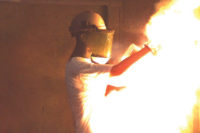Why didn’t workers wear the gloves?
First, they are expensive — 10 to 20 times a normal work glove. Second, they are difficult to work with since most work requires wearing protector gloves over the rubber glove, making small parts like screws difficult to handle.
Standards stifle change
ASTM D120 is the standard for VR gloves. ASTM F18, which is mostly populated by electric utility representatives, developed this standard. The VR gloves in this standard have two primary purposes: to totally protect from shock from higher voltages (the thinner, low-voltage VR gloves were not even allowed until 1995 when Class OO was added) and to last a long time.
Line workers do energized electrical work on a regular basis so this standard is focused on that type of use. The pat answer to the question, “What about my hands?” is, “Wear voltage rated gloves and protector gloves as required by OSHA.”
But the pat answer doesn’t consider the full scope of the issues.
Prior to 1999, there were no arc flash standard tests and the standards world has been playing catch-up ever since. In 1994, OSHA implemented 29 CFR 1910.269, which forced electric utilities to implement flame-resistant (now called arc-rated) clothing which would “not increase the extent of the injury” in an arc flash event.
This moved the National Fire Protection Association (NFPA) to upgrade NFPA 70E Electrical Safety in the Workplace (for industry) and the IEEE (Institute of Electrical and Electronics Engineers) NESC (National Electric Safety Code), primarily for utilities, to implement solid work practices for arc flash and shock.
Still, what about the hands?
When arc flash standards for clothing were developed in the 1990s, gloves were not even considered. Gloves, in ASTM F18, mainly meant VR gloves meeting ASTM D120. (D120 requires gloves to be a certain thickness of rubber and pass a voltage test. There is no allowance for any innovation with thinner rubber with additives for strength or for other materials. This standard is for gloves that have changed little for almost 100 years. There are no other performance requirements which limits improvements to even rubber).
“Protector gloves”, as OSHA calls them, are usually leather, meeting ASTM F696. Though most of the VR gloves worn in utilities are Class 2, which is designed and tested for 17,000 volts maximum use voltage. Meter service personnel use Class O, 1000-volt gloves. In fact, VR gloves for less than 1000 volts (that is Class OO 500 volt gloves) weren’t even mentioned in ASTM F496 (the selection, care and use standard for rubber gloves) until December 1995 and the leather protector standard dates to 1991.
Note that OSHA standards focus on Class O and greater. (This portion of OSHA has not changed since 1991 for the 1910.300 series and 1994 for the 1910.269 series, which are slated to update this year).
So the standard for rubber insulating gloves and leather protectors are what I call “standards after the fact”. These are standards that are really product specifications with little or no performance-based criteria. These types of standard hold back innovation.
Addressing hand hazards
Until about 2000, only two manufacturers in the U.S. made VR gloves, and imports were unheard of when NFPA 70E increased the market for rubber insulating gloves by moving these gloves to the mainstream for shock and arc flash protection. As the arc flash standards rolled out, the NFPA 70E committee noted that not all the deaths and serious injuries occurred with electricians. Many were occurring with operators and others who only operated low voltage equipment. When low voltage equipment is operated with equipment doors closed, the task is considered to be free from a shock hazard but arc flash hazard is still present. This is not always considered true of high voltage equipment (>600V).
In 2000, the ISSA (International Social Security Association, a workers’ compensation insurer’s group based in Germany) published its Guideline for the selection of personal protective clothing when exposed to the thermal effects of an electric arc (a new version was published in 2011 and is available at no cost at http://www.issa.int/). The ISSA had the first published study on hands and electrical hazards. As expected, the hands were one of the worst hit parts of the body (see Figure 1).
Table 1 shows the progression of language in NFPA 70E to require protection of the hands from electric arc and the steady growth of this committee’s knowledge about the hazards and the hand protection options.
Standards still fall short
In 2009, NFPA 70E added the term “arc-rated gloves”. It was assumed at that point that rubber gloves and leather protectors would usually provide thermal protection from electric arc burns to the hands. (This is now questioned but most anecdotal evidence is still in its favor; only a few hand burns and rubber glove ignitions have occurred and these are not the norm.) The problem still exists for workers who are not doing work that requires rubber gloves and leather protectors, which are quite expensive specialty gloves and require di-electric testing every six months. Rubber insulated gloves with leather protectors are really unsuited for every operation of an electrical device and some industries — such as pharmaceutical and many cleanroom applications — cannot use leather protectors at all. NOTE: VR gloves are normally required for operating devices >600V and high voltage devices are rare in cleanroom applications.
What if my machine operators, pipeline workers or refinery workers need to operate an electrical device with little to no shock hazard?
NFPA 70E-2012 assumes leather gloves that are >0.7mm thick will provide adequate protection up to 8 cal/cm². The problem with this new citation in the standard is that normal leather gloves are not sold with a guaranteed minimum thickness and leather protectors can only be worn over rubber insulating gloves or must be removed from service. Another issue is that only high-voltage leather protectors guarantee the minimum thickness, and they are rarely made of pure leather. They often have melting components. Leather protectors are not a good answer since they are sized to wear over a leather glove rather than directly on the hand.
Jim (not his real name) worked for a refinery as a mechanic. He commonly worked on pumps and other devices and used several different gloves for his work. Leather used to be his glove of choice, but cut-resistant nylon gloves with an ASTM F1790 cut resistance level 4 protection had become his new favorite. As Jim was operating an electrical device, an arc flash ignited and melted the glove onto his hand. Had Jim used leather, he could have been protected, but leather didn’t have the same dexterity and had little or no chemical resistance, which his cut-resistant glove did. Most companies don’t think about hands for arc flash protection of non-electrical workers, so Jim’s company had no policy for gloves exposed to electrical hazards other than electricians.
They do today. What if gloves you wore every day for cut, grip and common chemical protection could also have an arc rating? They can, but the standard is not yet final.
Without a standard, several innovative companies have forged ahead and combined to support standard development using ASTM F1959 with a modified panel. The data from this test method is statistically significant and the only argument to date has been from three utilities over which gloves require testing.
Since the hands are the closest body part to an arc, even without a standard, OSHA requires protection of workers from known hazards. NFPA 70E, IEEE 1584 and OSHA 1910.269 have made arc flash a known hazard and NFPA 70E requires protecting the hands when performing electrical tasks including operating of circuit breakers and disconnects.
Innovation coming
Arc-rated, cut resistant gloves. These are already on the market. A new standard for arc rating gloves will likely legitimize them in 2012-2013. These are likely to be the most accepted arc-rated glove for those hazards that do not include arc flash. They are much less costly than VR gloves with protectors and can we worn all day in most jobs.
Arc-rated chemical-resistant gloves. These are possible today but no arc-rated version is currently on the market. Nitrile gloves will ignite, melt and burn. For hand protection, a flame-resistant glove with a non-melting lining is critical for arc flash or flash fire. With testing, it might be possible to wear a two-glove system to protect from arc flash/flash fire and chemicals. MSDS is critical to choose the glove for the hazard and an arc flash or flash fire rated system will be critical for determining protection from the thermal hazard.
Better, thinner, longer-lasting and more protective arc-rated VR gloves. This is possible but without a standard change to performance-based characteristics, it is unlikely.
What about non-leather VR glove protectors? This is the most likely. In the U.S. there is no standard for this but neither is there a standard necessarily prohibiting this. OSHA 1910.269 for generation, transmission and distribution (commonly electric utilities) require VR gloves meeting D120, but they do not mandate F696 leather for protectors (though they are allowed by OSHA).
OSHA requires D120 and with “protector gloves” in 1910.137(b)(2)(vii) but does not require F696. Protector gloves should meet some standard to be cut and puncture resistant (to whatever level is needed by the task), but leather might not be the only answer or the best answer. In the EU, there is no standard requiring protectors. The international standard requires voltage-rated gloves to protect from shock with a test method similar to the ASTM D120 standard. CalOSHA is the only state plan we could find that incorporates leather protectors by reference. Fed-OSHA is rightfully silent.
Arc flash protection for leather is quite impressive with close to 25 cal protection for many leather protectors, but leather has several weaknesses:
n Leather is not nearly as good at cut resistance as many other glove materials.
n Leather has very poor chemical resistance. Light chain hydrocarbons like hydraulic fluid and transformer oil or diesel fuel pass through leather almost instantaneously and are easily held in leather allowing leather gloves to ignite and burn quite readily
What might work for protectors? Para-aramid (and blends) gloves with a coated palm are commonly available for cut resistance and might make an excellent VR glove protector. One of the biggest complaints of electricians with VR gloves is the leather protector slipperiness, inability to launder when exposed to chemicals and lack of true cut protection. With treatments or impregnation of different materials, para-aramid knit gloves are more cut resistant than leather and can even be more puncture resistant if needed. The better grip and thinner feel can make a better combination for most if not all electrical work.







